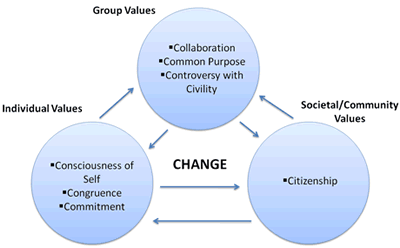Social Change Model of Leadership Development
Established in 1994, the Social Change Model approaches leadership as a purposeful, collaborative, values-based process that results in positive social change. The Model was built upon the following assumptions:
- Leadership is concerned with effecting change on behalf of others and society
- Leadership is collaborative
- Leadership is a process rather than a position
- Leadership should be value-based
- All students (not just those that hold formal leadership positions) are potential leaders
- Service is a powerful vehicle for developing students’ leadership skills
The Social Change Model of Leadership based on seven dimensions, or values, called the “Seven C’s”: consciousness of self, congruence, commitment, common purpose, controversy with civility, collaboration, and citizenship. All seven values work together to accomplish the transcendent “C” of change. Each dimension interacts with one another as shown below.
The Model

The individual dimension consists of the values: consciousness of self, congruence, and commitment. The group dimensions consists of the values: common purpose, collaboration, and controversy with civility. Finally, the societal/community dimension consists of the value of citizenship. All of the values contribute to the ultimate goal of change.
The "Seven C's"
- Consciousness of Self: Awareness of the beliefs, values, attitudes, and emotions that motivate one to take action.
- Congruence: Thinking, feeling, and behaving with consistency, genuineness, authenticity, and honesty.
- Commitment: Motivational energy to serve and that drives the collective effort. Commitment implies passion, intensity, and duration.
- Collaboration: Working with others in a common effort. It constitutes the cornerstone value of the group leadership effort because it empowers self and others through trust.
- Common Purpose: Working with shared aims and values. It facilitates the group’s ability to engage in collective analysis of the issues at hand and the task to be undertaken.
- Controversy with Civility: Recognizes two fundamental realities of any creative group effort: that differences in viewpoint are inevitable, and that such difference must be aired openly but with civility.
- Citizenship: Process whereby the individual and the collaborative group become responsibly connected to the community and the society through the leadership experience.
Change: “Hub” which gives meaning and purpose to the 7 C’s. Change, in other words, is the ultimate goal of the creative process of leadership - to make a better world and a better society for self and others.
Goals
The Goals of the Social Change Model are to develop in each student participant the ability:
- To understand one’s talents, values, and interests, especially as these relate to the student’s capacity to provide effective leadership. To develop the capacity to mobilize one-self and others to serve and work collaboratively
- To facilitate positive social change in their community. That is, to undertake actions which will help their community to function more effectively and humanly.
These goals are met through a series of evening activities which provide opportunities for the students to reflect, team build, collaborate and develop commitments they will take home with them. At the conclusion of the program, students give an individual personal presentation on how they will apply the knowledge gained towards being "A Leader in Caring for the Earth".
